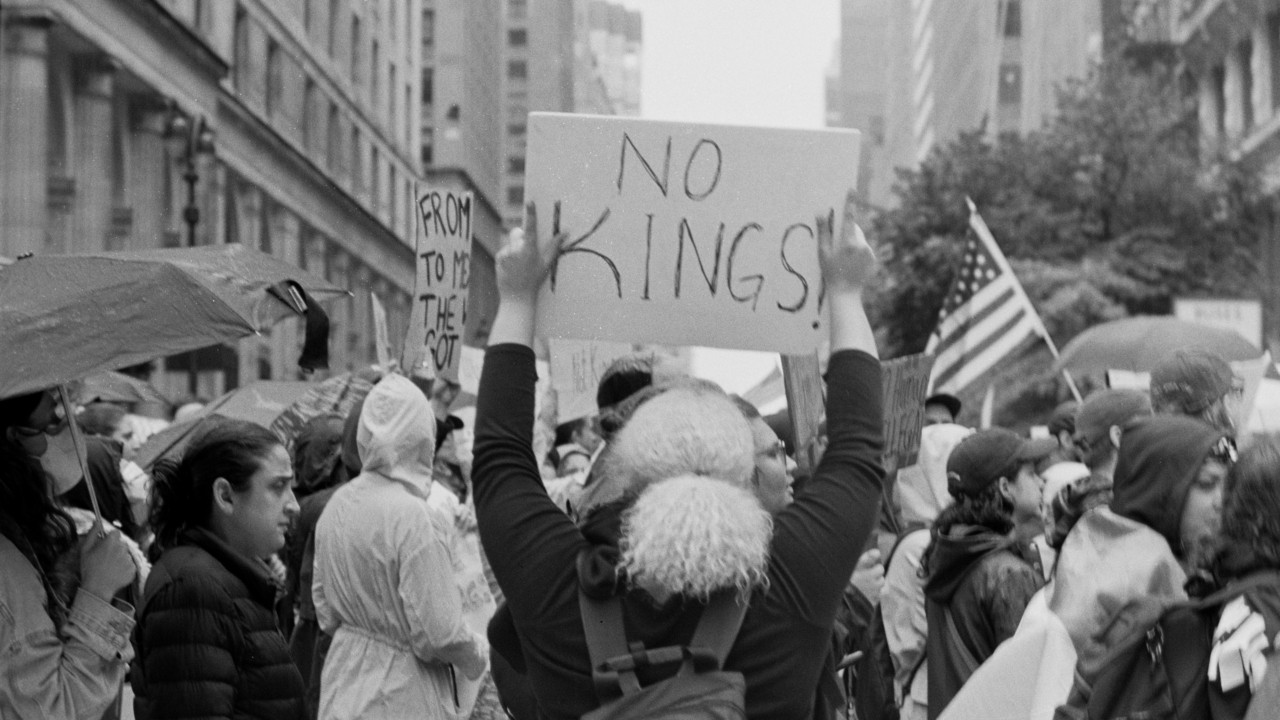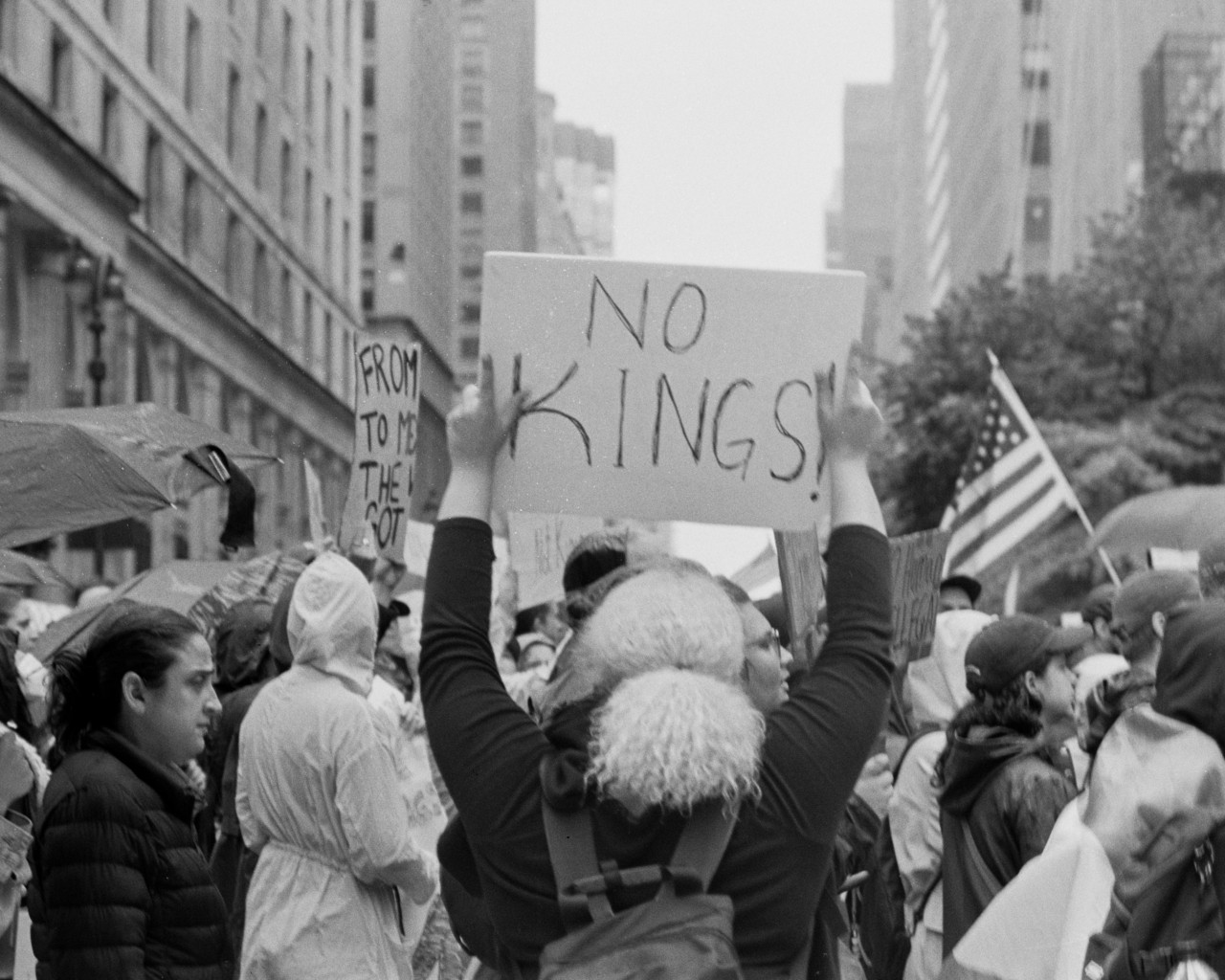

Photograph by Uliana Storoshchuk
words by miranda green
Roughly 7 million people took part in the No Kings rallies across the country last weekend.
Protesters came dressed in colorful costumes that included a plethora of Uncle Sams, Lady Libertys, and even frogs to defy characterizations that the demonstrations would be violent and hate-filled. People carried signs targeting attacks on abortion rights, Trump’s connections to Jeffrey Epstein, and his many cozy relationships with billionaires, tech moguls, and the fossil-fuel industry.
The rally was considered one of the nation’s largest single-day protests in history, but it was far from this year’s first. For months, Americans have challenged National Guard deployments, ICE arrests, Supreme Court rulings, and DOGE layoffs in an attempt to tackle rapid-fire policy changes emerging from the federal government.
Now, civil rights and political activist groups are recalibrating how they can meet the moment. Climate activists, in particular, are working to balance effectiveness with not losing sight of the looming threat of climate change.
The climate movement’s role evolves with every administration, but this year’s swift reversals of climate policies have left environmentalists who personally helped pass protections or set national climate goals in despair.
“What we are facing right now is the evisceration of 60 years’ worth of environmental progress and a crisis of confidence within the environmental and climate communities,” Erich Pica, president of the advocacy group Friends of the Earth, told Politico this week. “Folks are kind of spinning about what is happening and how to address it.”
Knowing this, I wanted to talk to climate activist leaders about whether that mentality, and our current reality, is impacting their decisions when it comes to organizing. What they told me is that while they are more than aware that the tide has changed with this administration, they still feel there’s an ocean of opportunity when it comes to changing public sentiment and private-sector commitments.
For example, Stevie O’Hanlon, communications director of the youth-led Sunrise Movement, says organizers there decided over the summer to expand their climate-action focus to include protesting authoritarianism.
“Our mission remains the same,” she told me. “We’re trying to win bold climate action that needs to scale the crises we face and improve the lives of working people. But that’s not going to be possible unless we take on the threat right in front of us.”
Sunrise gained national attention in 2018 for staging a sit-in at then-House Speaker Nancy Pelosi’s office to campaign for a Green New Deal. It was around then that I first met O’Hanlon when I was a congressional reporter and she was not long out of college. The decision for Sunrise to expand their purview seven years later comes as their members—mostly college-aged students—see the impacts of Trump administration policies hitting them where they live on campus.
“If you cannot protest, if you cannot speak out, if students are getting expelled for raising their voices because administrators want to please the Trump administration, those are not the conditions in which we’re going to successfully be able to organize a movement of young people to fight for a Green New Deal,” said O’Hanlon.
Third Act, a climate action group for the 60-plus set, organized a day of action last month called Sun Day. The nationwide event, held on the fall equinox, celebrated the power of solar energy. Third Act founder, well-known climate activist, and author Bill McKibben told me the group’s focus this year is on rolling out renewable energy fast enough to slow down warming. One of its big initiatives targets local permitting rules to be more solar-friendly while appealing to the public utilities commissions that often determine those rules.
Writing in his newsletter last week, McKibben pointed out the need for climate activists to understand their fight is more universal than ever and encouraged people to “show up—right now that’s our best way to keep building the opposition.”
Todd Paglia, executive director of the 25-year-old environmental activist group Stand.earth, says his organization is doing the opposite of pivoting away from protesting. Instead, campaigns continue to be loud and unapologetic—and target some of Trump’s biggest corporate backers.
“We’ve been sued for hundreds of millions of dollars,” Paglia tells me. “We’ve had our offices invaded. We get death threats on a regular basis, like that’s just normal for us. And so this is a time to go full tilt and to push back on what the administration is doing.”
With a focus on holding the business and banking sectors accountable for their climate and environmental impacts, Stand.earth is focusing its efforts on calling out the technology companies that have reneged on their own climate commitments since Trump took office. Microsoft, they argue, is the biggest offender.
While individuals might worry that climate change is not a salient topic to protest when immediate threats to democracy are a concern, Paglia says he’s learned that the public can show up for both issues. Right before 9/11, he said, Stand.earth was focused on pressuring office supply stores, including Staples, to stop selling paper from endangered forests and instead stock recycled products. The organization waited a few months after the attack to schedule a rally, but Paglia recalls people cautioning him that it was too soon, too insensitive, that no one would show up. Instead, he said, it was their biggest turnout ever.
“There comes a time where people are tired of just sitting around and staying silent while, usually in those moments, like we’re having right now, governments and companies don’t sit back. They take advantage of the pause of the moment to move their agendas forward,” Paglia said. “And at some point, citizens are ready to fight back. And we’re at that moment.”
Even with increased vigor in political activism, protestors have good reason to be cautious—not just due to the potential for arrest, but also the potential to be surveilled.
Reports have found that the police are actively tracking protestors, using tools like social media scraping, AI facial recognition, scouring of personal cell phone data, and even deploying drones to monitor rallies from above.
“It is so easy to scoop up a tremendous amount of data, and the vector along which they collect that data is usually somebody’s political expression,” said Matthew Guariglia, senior policy analyst at the Electronic Frontier Foundation, a civil liberties nonprofit. “AI has enabled centralization and consolidation of data in a way that we’ve never seen before.”
As Guariglia tells me, a lot of the country’s surveillance history comes out of the 1990s eco-terrorist panic. Glimmers of it were seen again during the 2016 Dakota Access Pipeline protests in North Dakota, when private security groups—often working with the local police—used several tactics, including social media scanning and cell phone geo-location, to build cases against individuals and the groups they protested with, documents later revealed.
Many climate groups say they’re undeterred by increased surveillance. O’Hanlon of Sunrise said they are advising people in their organization to stick to protests with big numbers to avoid being targeted. Paglia said he tells BIPOC volunteers at protests to play things much more safely. Guariglia said it’s about being aware of the tools the government has and the reality protestors face when they show up at rallies and organized events.
“You have to be realistic about what police have done historically and what they are technically capable of doing,” said Guariglia, “I think everybody should protest. I think it is about finding your ways of expressing yourself that are most reasonable. And part of how you assess that is by having a knowledge of the surveillance landscape.”
Climate Protestors Are Pivoting, but Not Backing Down